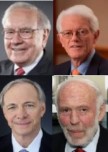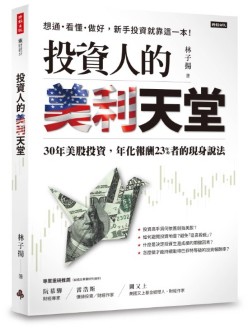My creteria
The criteria for the investment masters selected in this article mainly include the following:
- Several mainstream ways of stock market investment, including stock funds, quantitative investment, value investment, and hedge funds.
- Among the several mainstream ways of investing in each stock market, it is recognized as the one with the highest salary (main standard) and the one with the largest capital scale in the world (secondary standard)
- The investment career must be long enough, because we only care about the annualized return on investment for the entire career
Stock Fund Manager: Peter Lynch
Peter. During the 13 years when Lin Chu served as the fund manager of Magellan Fund, the annualized rate of return of the fund reached 29.2%, which is an astonishing and rare investment performance. He was named the world’s best fund manager by Time magazine and the most legendary fund manager in history by the American Fund Rating Company.
Quantitative investor: James Simons
James Simons is the greatest quantitative investor of all time. His Medallion Fund has a total of 31 years from 1988 to 2018, with an average annualized rate of return of 66.1% and a deduction of fees as high as 39.1%. This is the greatest lifetime investment cumulative effect of any published investor that I know of.
I checked all the information on the Chinese and English Internet and his related books. Simmons is the only investor who is closest to perfection──His Medallion Fund only had a negative return on investment in 1989. That’s an amazing achievement.
Please see my post of “The quant’s must-read book for Jim Simons “The Man Who Solved the Market”“
Value Investor: Buffett
Buffett has had a total of 57 years from 1965 to 2021, and only 11 years have had a negative annual return on investment, with an annualized return of 20.1%. With the size of the funds under Buffett’s control, this is a “very, very” difficult achievement.
In the book “The Rules of Super Growth Stocks Investing“: Section 1-1, page 21, in the discussion on the theme of “Long-term investment will be successful”, I have analyzed Simmons and Buffett for you.
Hedge fund manager: Dalio
One of the world’s largest hedge funds, Raymond Dalio’s Bridgewater Fund’s Bridgewater Fund has an annualized rate of return of 11.4% since its inception in 1991 to the first half of 2022 (the S&P 500 index includes dividends The annualized rate of return for the same period is 11.24%). In the hedge fund industry, considering the size of his capital and the duration of the fund, it is considered a top performer, but it is almost the same as the S&P 500 index representing the US stock market.
A rare academic investment guru: Keynes
Keynes is the “only” famous figure who has the status of a legendary master of “both” economics and investment. There is a big difference between academia and the actual situation of real society. Usually, the return on investment of so-called academics or finance professors is not very good.
He has long been managing investment portfolios for King’s College in the UK, achieving the extraordinary achievement of achieving an annual investment return of 12.4% during a 21-year period.
The active components of his portfolio outperformed the UK stock index by an average of 6% to 8% per year for 25 years, earning him high praise from recognized stock investment gurus such as future generations Buffett and George Soros.
Regarding Keynes, please see my post of “John Maynard Keynes, Investment master“
Bill Miller outperformed S&P 500 for 15 consecutive years
From 1991 to 2005, the Legg Mason Value Trust managed by Miller achieved a total return of 980.45%, with an annual compound return rate of approximately 16.44%; and he retired in 2019.
Miller has outperformed the S&P index for 15 consecutive years, and his investment returns have been higher than the S&P 500 index during the same period. During this period, the S&P 500 rose 513.59%, with an annual compound return of approximately 11.53%.
It has outperformed the S&P index for 15 consecutive years, even better than another legendary fund manager Peter. He also achieved eight consecutive years of beating the S&P 500 index. Miller’s outstanding performance has resulted in the size of the funds he manages reportedly growing from $750 million in 1990 to $20 billion in 2006.
Conclusion
| Fund size (US$ billion) | Period | Number of total investing years | Annualized return | Number of negative return years | |
| Buffett | 350 | 1965-2024 | 60 | 19.9% | 11 |
| James Simons | 34.8 | 1988-2018 | 36 | 40% | 1 |
| Peter Lynch | 14 | 1977-1990 | 13 | 29.2% | N/A |
| Bill Miller | 20 | 1991-2005 | 15 | 16.44 | N/A |
| Dalio | 100 | 1991-2022 | 32 | 11.4% | N/A |
| John Keynes | 0.052 | 1928-1945 | 18 | 13.2% | 5 |
| Charlie Munger (Wheeler, Munger & Company) | N/A | 1962-1975 | 14 | 19.8% | 3 |
| George Soros | 5.9 | 1969-2002 | 34 | 28.6% | 4 |
| Seth Karaman | 25 | 1987-2013 | 26 | 20% | N/A |
| Benjamin Graham | 0.005 | 1936-1956 | 21 | 20% | N/A |

Related articles
- “Investment Return, be careful of the numbers pitfall“
- “Imitating great investors is the fastest and most effective way“
- “Jim Simons, the lord of quantitative investing“
- “The quant’s must-read book for Jim Simons “The Man Who Solved the Market”“
- “Commonalities in Quantitative Investment“
- “How to research successful investment masters?“
- “The correlation between fund size and return on investment“
- “The larger the portfolio, the lower the return on investment will possibly be over decads“
- “The career annualized return on investment of top investment masters: Buffett, Simons, Lynch, Dalio, Keynes, Munger, Soros, Miller, Karaman“
- “Why Buffett deserves further study“
- “John Maynard Keynes, Investment master“
- “Keynes’ investment principles and achievements“
- ““One Up on Wall Street”, Peter Lynch’s great book for investing newbie“
- “What helps Buffett to get his investment idea?“
- “The commonalities of Buffett portfolio – cheap, fixed income, repurchase“
- “Investors should care annualized rate of return (IRR), How to calculate?“
- “Checklist to see if your return on investment is good or not?“
- “The correlation between fund size and return on investment“
- “The larger the portfolio, the lower the return on investment will possibly be over decads“
Disclaimer
- The content of this site is the author’s personal opinions and is for reference only. I am not responsible for the correctness, opinions, and immediacy of the content and information of the article. Readers must make their own judgments.
- I shall not be liable for any damages or other legal liabilities for the direct or indirect losses caused by the readers’ direct or indirect reliance on and reference to the information on this site, or all the responsibilities arising therefrom, as a result of any investment behavior.
